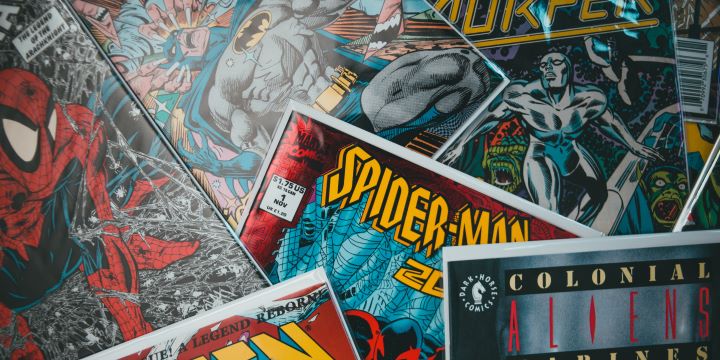Unveiling the Wonders of Modern Comic Book Printing Techniques

The quality of a comic book depends on several factors, from the paper used to the printing process itself. When working with a reputable printer, you can ensure that your story will be delivered as intended by the artist.
Before digital technology, comics were printed using spot colors, one color at a time. This method was replaced with the Ben-Day dots method, which uses small overlapping or widely-spaced colored dots to create shading and other effects.
Black-and-White Printing
For comics that feature line art, using black-and-white printing techniques is essential. It allows for the best reproduction of fine lines and details and keeps print costs down without sacrificing quality.
Standard comic books are printed on heavier paper or 50 lb (70 gsm). Depending on the presentation desired, this may be matte, half-matte/satin, or gloss-coated. The paper is held together with either PUR glue or stitched binding, which can resist rapid degradation caused by constant handling by readers.
Historically, comic book printing used the spot method, which involved placing a separate metal plate for each color: Cyan, Magenta, Yellow, and Black (reserved solely for Sundays). Examine an old comic closely, and you’ll see the tiny dots that comprise halftone graphics. These dots can be widely spaced, closely spaced, or overlapping, making the colors more realistic.
As the art in comics became more sophisticated, publishers replaced the spot printing process with Ben-Day dots, which used small colored dots that were tightly or loosely spaced to create different colors and shading. It was less costly than the four-color process but produced a less accurate and vibrant color range.
Today’s digitally illustrated comics can be printed in many ways, and with the right printer, your work will surely impress. When speaking with your printer, ask about their proofing processes to ensure the final product looks its best.
Digital Printing
Comic book readers may not realize it, but a considerable team is required to make their favorite heroes come to life on the page. Dozens of people handle specialized roles, from the writer to the penciller, inker, colorist, letterer, and editor. Once the story is complete, it’s sent to a printer to produce physical copies that can be sold and distributed in stores or online.
In the past, most comics were printed on newsprint, a cheap, off-white paper with a rough texture. This material can be yellow with age and may need to provide a better surface for vibrant colors or sharp lines. It’s been replaced by a more durable option called uncoated stock, which is smoother and won’t yellow as quickly.
Today, comics are usually colored digitally, using a code that relates the four base colors to the desired tone. The printed image is then transferred to large sheets of paper, fed between rotating printing plates for up to eight individual pages at a time.
A glossy finish enhances the look of the printed comics and can help them stand out in shops or online. The choice of paper is also essential. It can be gloss coated, adding a shine to the finished product, or matte, giving it a flat, natural appearance.
Offset Printing
Before computers came along, comics were printed with traditional offset lithography techniques. The artwork was separated into individual plates, one for each color, which were then printed onto large sheets of paper or, in some cases, a long roll of paper cut, folded, stapled, and bound together to form the finished book.
The spot coloring method used in older comics was later replaced by a Ben-Day dots process, where small colored dots were positioned closely together or widely spaced to create different colors and shading. Modern comics are almost always colored digitally using a code that relates the four base colors.
Once the writing and illustrations for a comic have been completed on a computer, either by an experienced comic book illustrator or with a digital art tool, they need to be optimized for printing. It means checking the gutters, margins, and text size to proportion them correctly. It is also worth ensuring that any choice of binding has been carefully considered, as this can affect how the finished product sits and feels in the hand.
Choosing the right paper for a comic can also make it more appealing to the reader and add a high-end finish. Some of the more popular choices include textured uncoated stock that gives the pages a more decadent feel and resists yellowing over time or silk paper that offers an extra glossy coating that enhances the images and contrast of the lines.
Four-Color Printing
Four-color printing is a popular choice for comic books. This type of printing uses cyan, magenta, yellow, and black ink to produce the desired color. This cost-effective method allows for a broader range of tones than spot colors. This printing technique is also used for color illustrations and photographs.
The process begins with the artist making a rough sketch of each page in pencil. Once the sketches are complete, the artist begins coloring each page. Traditionally, coloring was done by hand with a brush and ink, but today, most comic book artists use digital coloring software. Once all the pages have been colored, a proof copy of the entire comic is printed for final approval before it’s mass-printed.
Before digital printing became available, comics were printed using spot color printing. This process separated the images into individual plates for the four CMYK colors. These plates were then placed on a press, where the paper was printed. The pages were then cut, trimmed, folded, collated, signatures created, and stapled together into the finished comic book.
In the past, many comics were printed on newsprint with Ben-Day dots to add color and tonality. These dots were closely or widely spaced and could be combined to create various shades of color. The technique was popular with pulp comics because it allowed them to be produced quickly and economically since they didn’t require solid fields of ink.




































